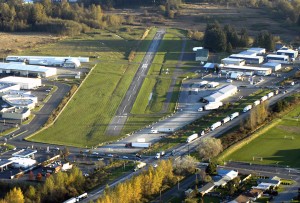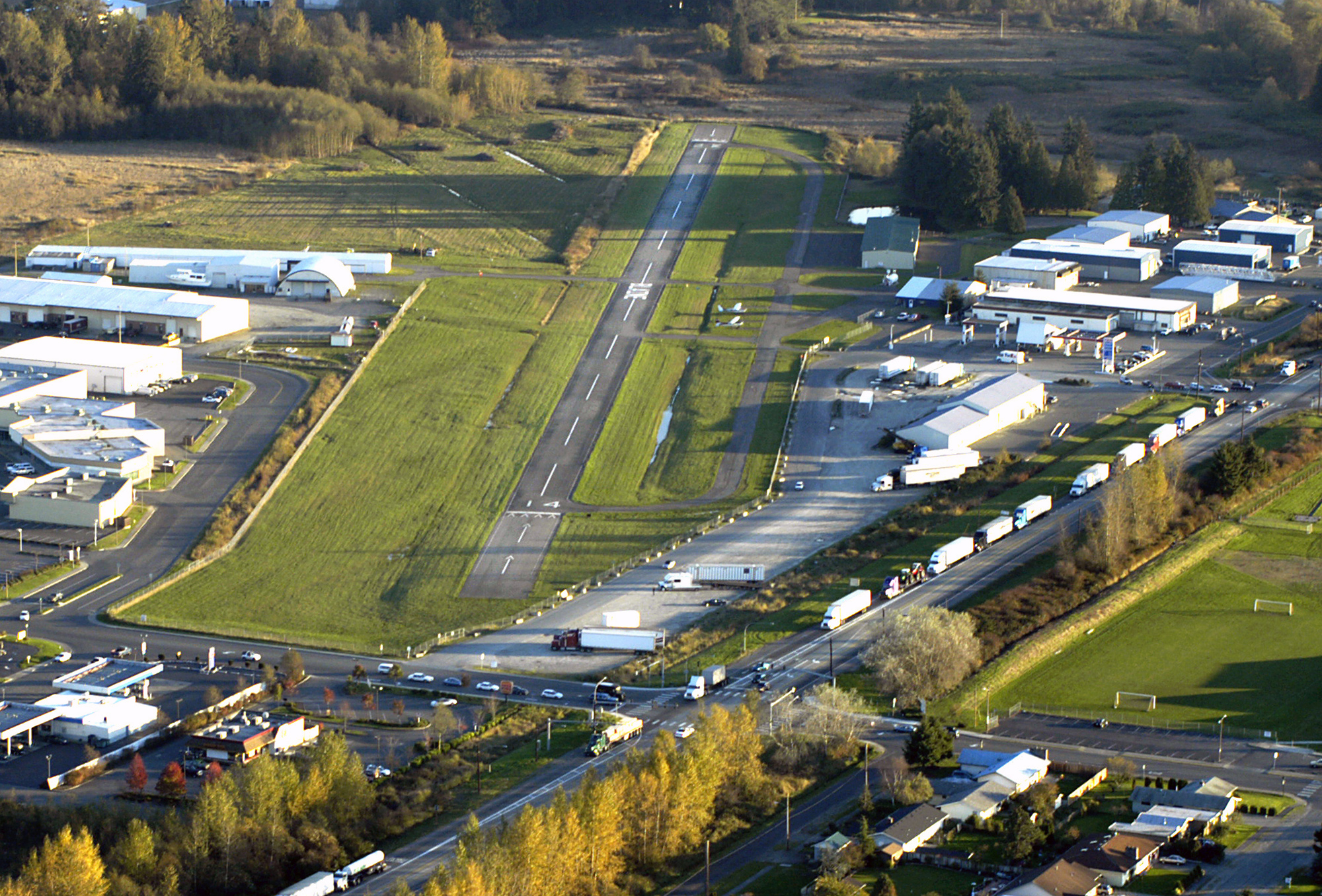By Terry Stephens

A $16.8 million upgrade and a new master plan for Blaine Municipal Airport, near the Washington-Canadian border, is designed to bring new business to the town’s airfield.
One of the smallest and most controversial airfields in America, Blaine Municipal Airport (4W6), has survived 28 years of lawsuits and ballot issues, aimed at shutting it down to make way for industrial and retail development.
Today, the 42-acre facility in northwest Washington, at the edge of the U.S.-Canadian border, is facing a much brighter future. A close 4-3 city council vote Oct. 9 approved moving ahead with the airport’s master plan, which includes a $16.8 million runway improvement, additional hangars and a marketing program.
A $15 million Federal Aviation Administration grant will primarily finance the 20-year development. The state, city and local private investments will add an additional $1.8 million.
Part of the plan includes bringing the airport up to FAA standards, including moving the 2,500-foot-long runway farther south and widening it to handle twin-turbine, business-type aircraft. Along with upgrading the facilities, the city will promote marketing efforts to attract new business to increase revenues and the airport’s value to the community.
The airport is home to 16 aircraft, and reports more than 5,100 flight operations and 1,600 visitors each year. The Washington State Department of Transportation’s Aviation Division records show the facility presently supports 10 employees, with $136,000 in total wages. Tenants and general aviation visitors provide $625,428 in revenue for the airport, and indirect economic impact is estimated at $145,126.
A successful expansion could bring in enough money to finally settle the question that has dogged the airport for nearly three decades: “Would that scarce land, representing more than half of the property zoned for industrial development in this town of 4,000 residents, be more profitable as an airport or an industrial park?”
“In October 2005, in response to a local group’s efforts to put the airport up for sale, the council decided to put an advisory measure on the ballot that would approve a feasibility study for the airport site’s future,” said Gary Tomsic, Blaine city manager. “One option examined in the study would be to close the airfield.”
When 57 percent of the 693 voters approved the study, the city hired a transportation planning consultant, Paul Sorenson of BST Associates in Bothell, Wash., to conduct a $20,000 analysis of local land uses, economic data and closure costs. Shutting down the airport, for instance, would require buying out existing hangar leases and cleaning up the site for its transformation into a mix of industrial and retail uses. Along with Sorenson’s study, the council appointed an alternative land use committee, including half a dozen business people, to provide their impartial view of the airport issues.
The consultant’s report estimated the city could sell the property for $5.7 million and, by 2025, create 332 new jobs and add $149,000 annually to city revenues. However, city attorney Jon Sitkin reminded the council that the city might need to spend as much as $4 million, just to buy out the leases of airport tenants. The city would need to repay FAA airport improvement grants received over the years, and the expense of removing and grading the runway, to prepare the site for other development, could cost as much as $400,000, Sitkin said.
An important decision
“This is the most important decision that you will make the entire time you’re on the city council,” Art Lawrenson told the council.
Lawrenson, who has owned nearby Motel International for more than 40 years, warned the elected officials to be wary of statistics, saying predicted benefits of closing the airport were really nothing more than guesses.
“Now is not the time to give away city-owned property,” he said. “Watch the Port of Bellingham. They do not give away property; they acquire property.”
Blaine has 70 acres zoned for industrial development, including the 42 acres at the airport. Doug Fenton, chairman of the airport commission, said that even if the airport remains, it’s inevitable that manufacturing and industrial growth could still happen in the city or at the airport.
“So you can have your cake and eat it, too,” he told the council.
Councilman John Liebert, who favored selling the airport land for development, warned the council that the debate would continue as long as the city operated the airport.
“As long as that airport is at that location, the controversy will continue for years, and we’ll be in debt even more from the grants we receive,” Liebert said. “History does repeat itself. And the next time we meet to discuss the closure of the airport, this room will not be big enough.”
Councilman Ken Ely, who voted in favor of keeping the airport, said his decision was difficult, because the airport has been such a volatile issue in the community.
“I hope my vote was the best thing for Blaine, but only time will tell,” he said.
Blaine residents Billie Rowell and her sister, Dianna Borden, said they were thankful for the council’s decision to keep the airport. Their father, George Rowell Jr., built the airport in 1943, when it was known as Dierks Field, and maintained its operations until 1955.
“We’re celebrating,” said Rowell. “Council members applied a lot of thought to this issue. It was really apparent they wanted to make the right decision for the future.”
Efforts to keep the airport open received strong support from aviation groups, who wrote letters to the city council and appeared at council meetings to speak on its importance. Among the groups were the FAA, Washington Pilots Association and the Aircraft Owners and Pilots Association.
Tomsic said the city has sent the airport’s master plan to the FAA and will be writing grant applications to fund the first phase of improvements.
Three decades of closure efforts
For longtime Blaine residents, the year’s airport turmoil had a familiar ring to it. The airport’s future seems to have always been in doubt. For nearly three decades, several lawsuits, four ballot issues and various city councils have attempted to close the airport. Generally, opponents have wanted to sell the land to real estate interests for industrial and retail developments. Last November, the whole question was back where it started.
The future of the airport was first questioned in 1978, when the city council narrowly approved a November general election ballot measure, asking to sell the facility. It was rejected by only 14 votes.
In 1979, a Canadian investment company offered to buy the airport for $309,000, to build an industrial park. The city council rejected the offer. Only two years later, the council voted to close the airport by 1982. In April of that year, a court decision ruled that closing the airport would be a breach of contract with a major tenant.
Aero International, an airport tenant, proposed buying the airport from the city in 1984, but a council vote rejected the offer. Two years later, the company sued the city for $2 million over airport safety issues. By fall, Dale Ennor, city manager at the time, told Port of Bellingham commissioners the city wanted to sell the airport. A few months later, in early 1987, the city council again voted 4-3 to close the airport and sell it, but later, after further discussion, backed away from that decision.
In May 1989, voters approved an advisory measure to keep the airport open, but only by 11 ballots. A few years later, in 1992, residents of Blaine presented an initiative for the fall ballot to close the airport. In the election, 53 percent of the voters supported keeping the airfield.
On a positive note, in July 2005, city officials created a 20-year, $16.8 million improvement plan for the airport, to be funded with FAA grants. That was enough to bring opposition from realtor Dennis Hill, who formed Revitalize Blaine Now, a citizens group that collected signatures for an initiative to close the airport.
Rallying to the airport’s support, city officials placed a court order on the county auditor to keep the issue off the November ballot. But a Whatcom County Superior Court judge removed the restraining order, and the city council put an advisory measure on the ballot to, once again, ask voters’ guidance in determining the airport’s future.
The balloting in 2005 showed 53 percent of the voters favored an economic study to determine if the airport was worth keeping open or if it should be closed. The study, which weighed the costs of closing the airport against the potential for improving it to gain more revenue, convinced the council to approve moving ahead with the original 2005 expansion and upgrade plan—by only one vote.
Even as the processing of the FAA grant moves ahead, the saga of the Blaine Municipal Airport’s love-hate relationship with the city’s residents may not be over yet.
Hill, who launched the fall campaign against the airport in 2005, said he was upset by the council’s decision. Working through his protest group, Revitalize Blaine Now, he said he plans to continue his efforts to close the airport.











